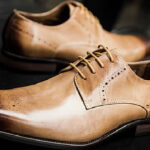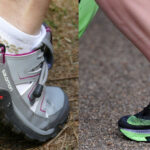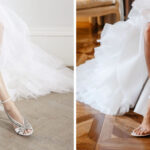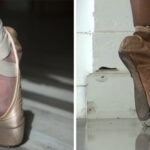How often have you been in the middle of a walk, only to feel that rubbing on your ankle? It’s not fun and it can be painful. Sometimes we just don’t know what to do about it. With the help of this blog post, you will find out 15 ways on how to stop shoes from rubbing the back of your ankle!

What Causes You to Rub Your Ankle While Walking
- Your shoes are too tight
- The back of your shoe is rubbing against the top of your foot (perhaps because you’ve lost weight or bought new, bigger shoes)
- You’re wearing high heels and they rub against the side of your heel every time you take a step.
- Your shoes have a very high back that is rubbing against the inside of your ankle
- You may be wearing poorly fitted orthotics or other foot supports.
- Your socks don’t fit well, which can cause irritation around and under the heel.
- The backs of your heels are pressing into the shoe’s insole as you walk…and it hurts!
- You’re not wearing supportive enough footwear for how much walking you do every day. (like if you spend most days on your feet)
The key to curing these problems is to try different things until something works! It might take time but with patience and persistence, we will find what helps us stop our shoes from rubbing at least one part of our body.
15 Ways How to Stop Shoes From Rubbing the Back of Your Ankle
Try a Shoe With a Wider Toe Box:
A wider toe shoe may help alleviate the rubbing at your ankle. A show with a wide toe box will have more room for your toes to flex and move around, which might help reduce the friction between the shoe’s insole and the back of your heel.
Choose Shoes That Are Well-cushioned and Have Plenty of Arch Support:
A well-cushioned shoe can help absorb some of the pressure on your foot. Shoes that have a lot of arch support will help prevent unnecessary movements and tugs at your ankle.
Find Footwear That Belongs to Your Correct Shoe Size:
A shoe that is too small or too large for you can cause rubbing, especially in areas like the back of your heel where there’s more contact with the inside of the shoe as it rubs against other parts. This could be because shoes are not big enough, causing them to squeeze together when walking; or they might be so loose-fitting that they move around while wearing them – which means they’ll just keep touching different parts all day long.
Apply Talcum Powder:
You can try to apply talcum powder to the back of your ankle to help reduce any excess moisture. This will both help to absorb the rubbing and also provide a layer of protection from it happening again in the future – whether that’s because you’re using talcum powder or not.
Try Wearing Two Pairs of Socks:
Try wearing two pairs of socks at once (one thin pair inside another thicker pair) in order to cushion the back of your foot against the shoe’s tongue and heel counter area. But I think it’s not a perfect method to do in summer because your feet will be very warm.
Change Your Shoes If Necessary:
If they continue to rub on your ankle, then try changing shoes sometimes so they can break in properly with no more rubbing! The rubbing might be caused by them being too new since their material is still rigid; if this happens, just give them some time before wearing again (and don’t forget about applying some talcum powder).
Change Your Lacing:
Others recommend changing how tightly you lace up your shoes so that no one area rubs too much. In some cases, loosening them might be necessary in order to relieve pressure near the back of the heel or Achilles tendon. Tight laces around these areas will greatly increase their chances of being rubbed raw — but when they loosen enough, this problem will usually go away.
Use Foot Pads:
Use footpads made specifically for relieving pressure points at the back of the ankle when wearing high heels (these should be worn under socks) OR try using silicone gel inserts inside your favorite pair of flats/sandals/flip flops – these will provide extra padding between your toes and heel so that there is less contact between them while walking around all day long!
Try Losing Weight:
If you’re overweight or obese, losing weight could relieve some pressure on your Achilles tendon and also help to prevent other foot problems.
Open Toe Shoes:
Try wearing open-toe shoes (like sandals) instead of closed-toe ones – this can relieve pressure on the heel/Achilles area by allowing for more room in the shoe.If you have a high arch, it may be best to avoid them altogether as they will put even more stress on these areas!
Wear Looser Socks or Heels with Padding:
Choose socks that are not too tight near your Achilles tendon — try walking around without any socks at all if possible OR wear heels with padding where there is extra cushioning between toes and heel.
Stretch Your Shoes if Necessary:
Put your shoes up on a table and stretch them out by pushing your toes towards the front of the shoe. You can also use a rolling pin or other objects to push against the heel for an extended period of time.This will make it easier for you to walk for longer periods without experiencing as much discomfort! You can check our article to stretch your leather shoes.
Use Shoe Inserts:
Put in inserts under your feet that have extra padding, or try foot orthotics if necessary — these may help relieve pressure points in addition to making it more comfortable when walking long distances. It’s best not to wear high heels with this type of insert since they’ll put even more stress on those same areas!
Go To Cobbler:
If you can’t find shoes that fit or are comfortable to wear, it might be time to visit a cobbler. We recommend trying on different types of shoes in person. It’s better to make several trips than spend money on the wrong type and have them not work out!
Consider Shoe Material Before Purchasing
There are different types of materials that are less likely to cause this problem. For instance, leather shoes may be more comfortable for long periods of time than synthetic ones since the latter can rub against your skin and cause discomfort where it touches.
Leather
Leather shoe isn’t flexible at the beginning, so you can’t wear the shoes for a long time. Leather shoes will break in after wearing them more than three times, so be patient when trying on this type of shoe and don’t give up!
Rubber
Rubber materials on shoes are great for people with sensitive skin and those who have problems with sweating. The rubber outsole will prevent your foot from slipping in your shoe which is a big problem for many people.
Fabric
Fabric shoes are more comfortable than other types of material, so it’s best to wear this kind of shoe if you want the most comfort possible.
Suede
Suede is a type of leather that has a soft and smooth texture, but it’s not the most flexible type of leather. Suede shoes are also expensive because they take more time to make than other materials.
Mesh
Mesh shoe has gotten popular in recent years because it’s very comfortable for people with sweaty feet problem- many mesh shoes have ventilation holes at the top so your foot can breathe much.
Nubuck
Nubuck is a type of leather that has been sanded to give it an attractive and soft appearance. Nubuck shoes are usually less expensive than suede since they do not take as much time to make.
Frequently Asked Questions
Why Do My Shoes Rub the Back of My Ankle?
It is possible that your shoes are too tight or the wrong size. This can cause a rubbing sensation on the back of your ankle and make it uncomfortable to walk in them. A better solution would be to try different shoes until you find one that fits properly.
Does Vaseline Stop Shoes Rubbing?
Vaseline is an ointment that can be used to stop shoes from rubbing and creating blisters. It is a petroleum jelly that contains petrolatum, which creates a protective barrier on the skin. The benefits of using Vaseline are:
- It reduces friction, so it prevents rubbing and pain caused by shoes.
- It keeps your feet moisturized, which prevents dryness and cracking.
- It also works as a water-resistant barrier against moisture coming in contact with your skin or shoe material.
Why Do New Shoes Rub Heels?
New shoes rub heels because the inner lining is not yet broken in. The material used to make your new shoes is too soft and needs time to adjust to your feet before it becomes more flexible. The next few days will help you get accustomed to your new shoes, and they will stop rubbing heels.
Why Do Wellies Hurt My Ankles?
Wellies are usually very heavy and have a lot of weight. This can cause pain in the ankles and joints.
This is because the ankle joint’s role is to absorb shock from walking and running, but wellies don’t provide that kind of shock absorption. The feet get a jolt when you take steps which causes the ankle to twist or turn inwards, resulting in pain for many people who wear them.
There are also times when your heel slips on the inside of the boot, causing you to fall on your foot and potentially sprain it.
Why Do My Work Boots Hurt My Ankles?
Work boots are not the most comfortable things to wear. One of the main reasons for this is that they can cause foot, ankle, and lower leg pain when worn without proper protection.
Here are some common causes of foot pain from wearing work boots:
- The boot’s design could be too tight or wide, leading to a bunion or bunions.
- The fit around your feet could be too tight, leading to friction burns and blisters on your feet.
- The boots may have poor quality leather, leaving your skin raw and irritated.
- You may have an incorrect size for the boots, which means that they don’t give you enough support around your ankles.
Conclusion
The back of the shoe rubbing your ankle is a common problem that many people experience. So how to stop shoes from rubbing the back of your ankle? There are several factors that contribute to this issue, but one way you can try and avoid it is by always wearing socks with your shoes.
If your feet sweat at all, you should also buy some mesh or nubuck shoes so they can breathe more and stay dryer longer. You could also purchase sturdy insoles if you think there’s too much room in the front of the shoe for any part of your foot to rub against anything else inside it.




